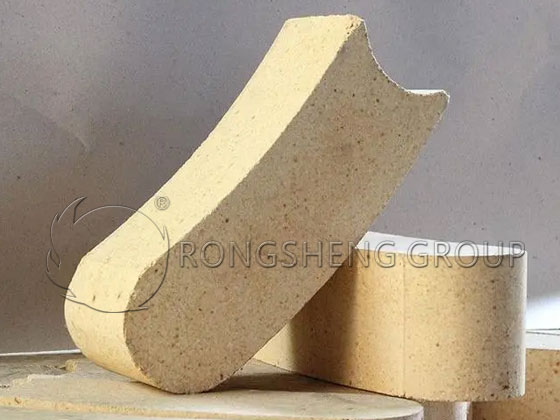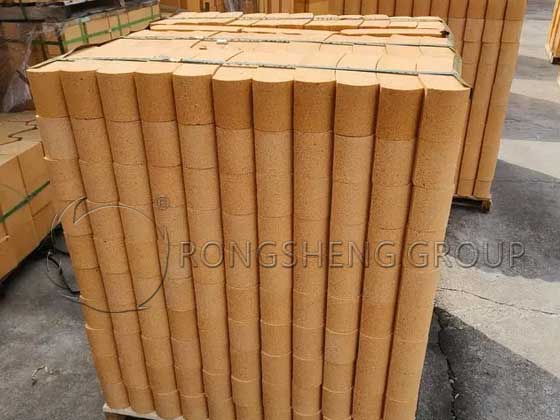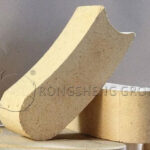The selection of refractory materials for the ladle depends on the working environment of the ladle. The lining is either constructed with arc bricks or integrally constructed with aluminum silicon carbide castables. It’s just that the packages used are different and the construction methods are different. High Aluminum C-type Curved Ladle Brick. To improve the ladle quality and extend the service life of the ladle, it is recommended to choose high-quality refractory lining materials.

Refractory Lining Material for Molten Iron Ladle
The materials used to build the molten iron ladle with refractory bricks include clay bricks, high alumina bricks, impregnated bricks, magnesia carbon bricks, and silica-alumina bricks. When building masonry, use fire clay of the same material. If integral casting is used, a steel mold is used and aluminum silicon carbide castable is used to cast it to a thickness of 100-200mm. Moreover, it must be baked with a special baking device before it can be put into use.
Of course, the materials of refractory bricks used in ladles with different tonnages are also different. Small ladles are often made of clay bricks because of their low cost. Large-tonnage ladles are built with aluminum silicon carbide bricks or zircon series silicon carbide bricks, or with high alumina bricks.
Whether refractory bricks or castables are used, the effect of use can only be determined based on the number of uses. Building with bricks requires baking, and casting with castables also requires baking. However, the baking methods and cycles are different, and the number of packages used is also different. The choice of these two depends on usage habits and usage conditions.

Performance of High Aluminum C-type Curved Ladle Bricks
- Long service life, increased by 210% with more clinker clay bricks.
- The reduction in unit consumption shows the good performance of high-aluminum Curved Ladle bricks. The reduction in unit consumption indicates a corresponding reduction in non-metallic inclusions in molten steel.
- Judging from the cross-section of the high-alumina brick lining of the molten iron ladle after use, the resistance to erosion by slag and molten steel is better than that of clay bricks.
- High-aluminum Curved ladle bricks have arcs at both ends, so the curvature can be adjusted when laying bricks. Therefore, it is easier and faster to lay refractory bricks. The joints between masonry bricks can generally reach 1 mm.
- The vertical brick joints of high-alumina universal arc steel-ladle bricks are smaller, 70% less than the vertical joints of standard refractory bricks. In this way, the molten iron layer moves up and down and the erosion effect deep into the brick joints is corrected.
- Due to the improvement in the quality of refractory bricks, the thickness of the lining bricks can be reduced, correspondingly increasing the capacity of the steel drum.
- Due to its long service life and convenient bricklaying, the labor required for building steel barrels is reduced and the efficiency of steel barrels is improved.
In addition, high-alumina ladle bricks are also resistant to high temperatures and can withstand long-term erosion by high-temperature molten iron without melting and softening. It is resistant to thermal shock and can withstand repeated erosion by molten steel without peeling off. It is resistant to the corrosion of slag and can withstand the corrosion effect of slag and changes in slag alkalinity on the lining. It has high mechanical strength at high temperatures and can stir and flush the molten steel. The inner lining is expandable. Under the action of high-temperature molten steel, the gaps between the inner linings are filled densely and become whole.

Construction of Curved Ladle Bricks in Molten Iron
In the foundry and smelting industry, molten iron ladles are usually used to contain molten steel smelted from electric furnaces. The smelting temperature of high-temperature electric furnaces is within the range of 1450°C. When the smelted electric furnace is filled with liquid that can be used to pour castings, it is then lifted by a crane in the workshop. The electric furnace pours the high-temperature molten steel inside into the ladle. The overall shape of the ladle is a conical cylinder with a larger upper part and a smaller lower part. Ladle is the main container for holding molten steel. Since it needs to withstand the high temperature of molten steel, it needs to be lined with a layer of refractory material.
The selection and construction of refractory materials in ladles are currently divided into two categories. One is to use unshaped refractory castables to form an integral mold to form an integrated furnace. The second method is to use molten iron-clad arc bricks for construction. Next, let’s learn about the method of ladle-laying Curved bricks.

The model and size of the hot metal ladle arc brick can be found in the new kiln masonry manual. In the kiln masonry manual, the models and specifications of Curved bricks for ladles are listed, which are also suitable for ladles. Commonly used models include the C model, the two most commonly used models are 280*100*100 or 280*100*80. Generally, small-size arc bricks can be used in molten iron ladles of less than 3 tons, and large-size Curved bricks can be used in molten iron ladles of more than 5 tons. The size of the arc brick is selected based on the inner diameter of the ladle. And it is necessary to ensure that the holding capacity after masonry cannot be less than the amount of molten steel after a single smelting.
Take a customer of our company as an example. This customer’s company mainly produces rolls. The workshop is equipped with a series of equipment such as electric furnaces, ladles, and heating furnaces. The company uses arc bricks to build ladles. Since their pre-stored Curved bricks were out of stock this time, they ordered a batch of molten iron laminate arc bricks from our company. Because I only asked about the model specifications and supply before ordering and did not have good technical contact. When the hot metal ladle Curved bricks were delivered to the use site, it happened that the bale-laying personnel in the workshop did not know how to lay the bricks. After our technicians arrived at the ladle-laying site, they found that the company was missing the starting bricks needed for ladle construction. Therefore, the on-site masonry workers do not know how to use and build masonry.

The masonry of molten iron-laden arc bricks is carried out ring by ring using a climbing method. It goes up gradually in a way similar to steps and is not built layer by layer. This is a misunderstanding caused by many factory masonry construction. Among them, there are 7 models of climbing bricks with molten iron laminate Curved bricks before bricklaying, and the length and arc of each model are similar, only the thickness is different. In this way, steps can be formed to move up.
Therefore, before ordering molten iron ladle arc bricks, technical communication on masonry must be done. Laminated iron Curved bricks are not built in a single model. Instead, you need to build a circle of the first 7 starting bricks and climb up the slope. This kind of masonry has no joints as a whole and is strong and durable.
Purchase high-quality refractory materials for ladles, High Aluminum C-type Curved Ladle Bricks, curved ladle bricks, 42% alumina ladle bricks, amorphous refractory materials for monolithic pouring – aluminum-silicon carbide castables. Rongsheng refractory material manufacturer, product quality is reliable and competitive price. Perfect customer service can ensure the long service life of the ladle lining. Contact us to get free samples and quotes.









